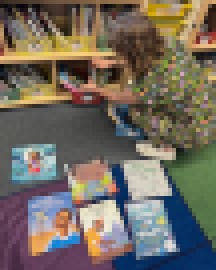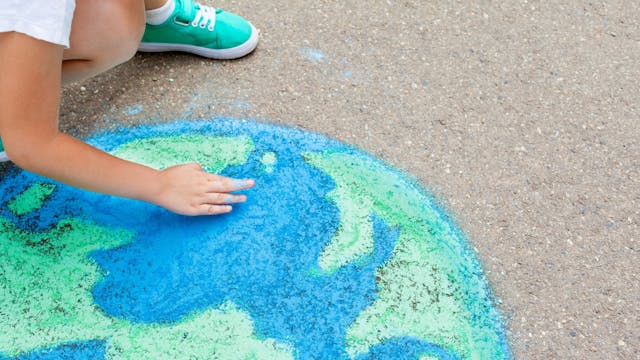Extreme weather events are on the rise around the globe, from historic floods to unseasonable heat waves and raging wildfires.
One doesn’t have to reach far to find fuel for climate-related fear and anxiety.
Heidi Rose, an elementary school teacher in Denver, Colorado, knows that all too well. She experienced years of what she describes as “pretty intense” climate anxiety, beginning around 2015, as she watched natural disasters unfold in the news and up close.
“I was having a hard time functioning and just continually thinking about how far past the point of no return we are,” she says, sitting on a too-small stool at a shared table in her first grade classroom at Lincoln Elementary School.
Her dismay seeped into her work, she acknowledges. Back then, she was talking with her students about climate and sustainability — as she has long done — but focusing too much on what’s broken, like how much trash is floating in the ocean.
These days, Rose has changed her approach — in part because she has developed a healthier outlook on climate change herself, but also because she sees that there are more effective ways to introduce young people to climate education and sustainability practices, especially early learners like her first graders.
“One thing that I think is really important when you're talking with the younger kids, especially, about it, is try to do it in a way that's centered around appreciation and love, and less about fear and doom and gloom,” Rose says. “I don’t want the first conversations they have about [the climate] to be super focused on problems or how bad things are.”
Rose is among a growing number of classroom teachers who, either by their own volition or through directives from their states, are introducing students to climate change and the forces behind it. In most cases, teachers are avoiding talking about it in a way that incites fear or makes the issue feel abstract to children.
Instead, educators emphasize the importance of imbuing hope in these classroom conversations. They also share that they are grounding these lessons in local realities and a focus on sustainability in their own communities, while emphasizing the interconnectedness of people and places across the globe.
Moving Away From Abstraction
Climate change is generally too big a topic to tackle with younger kids — think preschoolers, kindergarteners, first graders — says Mark Windschitl, professor of science education at the University of Washington and author of Teaching Climate Change: Fostering Understanding, Resilience, and a Commitment to Justice.
“It’s too abstract,” he says. “It’s bleak.”
But teachers can still play a key role in helping young learners develop the skills to think critically about this issue in the future. And they can help build foundational knowledge.
Windschitl, a former science teacher, says that sustainability is a good starting point — especially if it’s taught in a concrete way kids can grasp.
Telling children to throw their banana peels into a compost bin because it helps the planet, he says, is not all that effective. But explaining to them the process that begins after the compost bin gets picked up — and relating that back to their role in it — can be.
In her first grade classroom, Rose has a waste-sorting station that she introduces to her students at the beginning of the school year. She explains what a landfill is, discusses what happens there, and shows them videos so they can see what a landfill looks like. She does the same with compostables and the three different types of recycling bins in her classroom. (Rose has a personal subscription to Ridwell, a service that allows her to dispose of students’ hard-to-recycle trash.)

The goal of the waste-sorting station, she says, is to get the 6- and 7-year-olds in her class to think independently when they’re getting rid of something: Does this belong in the trash, a recycling bin or the compost bin — and why? It’s also to help them connect the dots on waste. “It’s not like we just put our plastic in a bin and it disappears,” Rose says. “It goes somewhere.”
“I try to plant the seed but not have it be tied to anything weighty or bring in any feelings of shame or guilt around it,” Rose adds, noting that many kids’ snacks come in plastic packaging, and that’s OK. “It’s more like a sense of intentionality and connecting what we’re using to where it’s come from. Just awareness and connectedness to the planet.”
Grounding Lessons in Local Examples
Another way teachers are making climate and sustainability more relevant to kids is by grounding lessons in local examples. The global scale of climate change is enormous. It’s easier for kids if they can first understand how it affects the people in their neighborhood, many educators note.
“We know climate change is very complex, very overwhelming, very difficult to understand,” says Manuela Zamora, executive director of New York Sun Works, a nonprofit that has helped open hydroponic classrooms in more than 300 public schools across New York City and New Jersey, where it also promotes science education on climate change and sustainability.
“We always go back to why and how is this relevant to me, then how is it relevant to my community, then my city, then my planet,” she says of the group’s climate change curriculum.
Local and community-based examples help students dispel the notion that climate change is some remote concern that only impacts the polar bears, Zamora adds.
“Kids are very present in the day they’re in, in the place they’re in,” notes Elaine Makarevich, who taught in an elementary school for 30 years before recently becoming the New Jersey state lead for Subject to Climate, a hub that connects educators to standards-aligned resources for teaching climate change.
In rural areas, like the one where Makarevich taught, mass transit is inaccessible. And it doesn’t make sense, she says, to encourage kids to walk or bike when it may take their families 20 minutes by car to get to the nearest grocery store.
“It’s different in different places,” she adds. “If you’re in a community with flooded homes, it’s a different concern. It’s very place-based.”
Once kids understand their local challenges, educators say, they can begin to connect the needs of their own community to the needs and experiences of communities around the globe.
Leading With Hope
Even when she taught children as early as kindergarten, Makarevich would try to instill in her students a love for the planet, an appreciation for how interconnected its inhabitants are, and care and concern for its future.
As students get older, those conversations get “deeper and richer,” she says. They can learn not only to respect the planet but to understand “how it works, what it gives us and what we give it.”
In every lesson, even those on the changing climate, “there was always that hopeful solutions base,” Makarevich shares. “That’s really important.”
Five-year-olds can help recycle in their classroom and cafeteria. They can plant flowers, she says. Ten-year-olds can take part in community cleanups or join the school’s “green team,” if it has one.
In Rose’s Denver classroom, she has two full bins of children’s books about conservation and the planet. Those help her to talk about the Earth in an “optimistic and honest” way, she says.

It’s still far from perfect. Every day, she admits, her elementary school uses 260 plastic utensils.
“We are kind of limited in the large changes we can make as a school, maybe even as a district,” Rose says. “I focus more on what is within my control as a classroom teacher instead of getting lost in what is outside my control.”
It’s not dissimilar, she says, to what she’s trying to communicate to her students. They may not be able to control the bigger drivers of climate change, even when they’re older, but they can develop an awareness of and a connection to the planet. And that’s a start.


